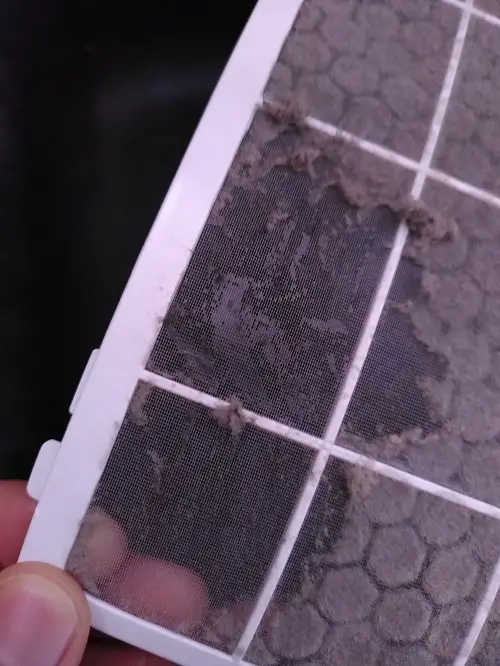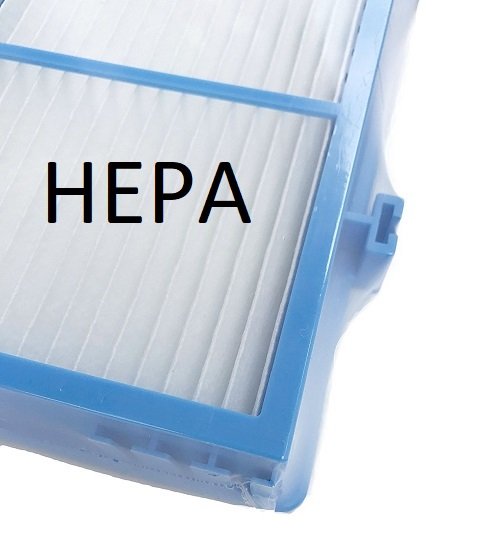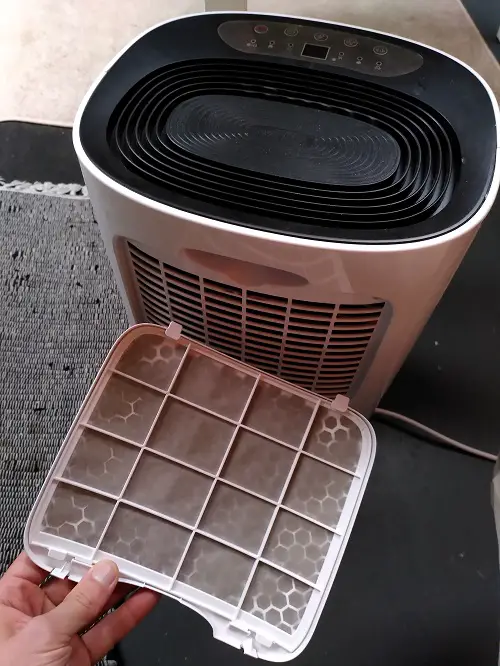Both air purifiers and dehumidifiers are equipped with the right filters to capture airborne mold spores. Therefore, they can be an effective means of reducing the number of spores in your air. However, air purifiers do not help get rid of mold growth. Dehumidifiers help tackle the underlying cause of mold growth by reducing humidity.

Mold growth is common in buildings and homes. It grows in areas with a lot of moisture, or high humidity levels. Molds release tiny, invisible spores (fungi seeds) into the air to spread and reproduce. Therefore, they enter buildings simply via the air.
Why we want to get rid of mold
Mold spores are always present in the air, regardless of whether you have mold growth in your home. Normally, they release their enormous amounts of spores into the outside air. Only a small part of this will enter your home. Your immune system is generally capable of dealing with small numbers of spores.
However, when molds start growing inside a building, the number of spores in your air can increase drasticcally. Instead of releasing their spores outside, large quantities of spores will be released directly into your home. Inhaling large amounts of fungi spores can be harmful to your health.
According to the CDC (center for disease control), some people are not at all affected by mold spores. Others are sensitive and can have symptoms like a stuffy nose or itchy eyes. People with a lung condition or mold allergy can have more serious symptoms.
On top of that, mold that grows damages its ‘food’ source. Therefore, your walls, furniture, upholstery, etc. are damaged by the growing mold.

What is the difference between an air purifier and a dehumidifier?
Both air purifiers and dehumidifiers come with one or more filters that remove airborne particles, including mold spores.
An air purifiers main purpose is to remove airborne particles. Therefore, it contains several different types of filters, depending on the specifics of the device. All air purifiers come with at least a general dust filter for large particles such as dust, and an additional filter for smaller particles.
Dehumidifiers are meant to reduce humidity levels. A fan runs the indoor air along parts that induce condensation, removing moisture from the air. This water is caught in a container so you can dispose of the water. They come with one filter that prevents dust build-up inside the device.
For more information about how dehumidifiers work, I recommend reading my article: How does a dehumidifier work?
Air purifiers:
- Are designed to remove airborne particles
- Have multiple different filters
Dehumidifiers:
- Are designed to remove air moisture to reduce humidity
- Have one dust filter
What type of filters are required to remove spores?
There are many types of air filters available. They are all rated on their effectiveness in removing airborne particles such as dust and mold spores. The most common rating scale is called MERV, or Minimum Efficiency Reporting Value. The well-known HEPA filters are also part of the MERV.
MERV has a range of ratings between 1 and 20. For a filter to be able to remove mold spores from the air, a MERV rating of at least 5 is required. That is on the low end of the rating scale. Therefore, almost all MERV-rated filters are suitable for removing mold spores.
However, the higher you go up the MERV rating scale, the more efficient the filters become. MERV 5 through 8 filters, for example, remove about 90% of mold spores. A HEPA (High Efficiency Particulate Air) filter (MERV 17 through 20) removes over 99.9% of mold spores (and other particles).
MERV 5 or higher is sufficient for mold spore removal. For the best removal efficiency, HEPA filters are recommended.

Filtering performance: air purifier vs dehumidifier
Dehumidifiers normally have one dust filter. It is usually around MERV 11, but can also be a HEPA filter.
Air purifiers normally have a pre-filter that captures larger dust particles and protects the next filter. The next filter is almost always a HEPA filter. Some air purifiers have an additional filter that removes odors instead of particles.
SInce HEPA filters are more efficient than lower-rated filters, they remove a larger percentage of mold spores from the air. That means that the air only has to move through the filter once to remove almost all spores (99.97%).
A MERV 5-8 filter, for example, has an effciency of about 20 to 70%. (For more detailed information about filter efficiency you can read my article here) Therefore, the air needs to go through the filter more than once to be able to remove as much mold spores as a HEPA filter would.
Conclusion
If both devices have a HEPA filter, they are both evenly well-suited to remove spores from your air. Air purifiers almost always have a HEPA filter. If your device has a filter with lower efficiency than HEPA, it will still remove spores, only less efficiently. Therefore, it will take longer to clean your air of spores.

How long does an air filter take to remove all airborne mold spores?
How quickly an air purifier can remove mold spores from the air depends on several factors. Among others, the speeds of the device, the removal efficiency of the filters, and the introduction of new spores determine the required run time. However, continuously running the device is recommended for optimal indoor air quality.
If you would like to find out how long a certain air filterr needs to run to clean all your air of mold spores, I recommend reading my article on required run time:
Mold removal: air purifier vs dehumidifier
Filtering the air with either an air purifier or a dehumidifier does little against already-established mold. The one thing it does is prevent the spores from reaching a new spot and start growing new mold.
To eliminate mold, you will need to remove all established mold. Additionally, conditions that can lead to mold growth cannot be allowed.
An air purifier does not help remove established mold or eliminate favorable mold-growth conditions. It only removes airborne spores.
A dehumidifier’s purpose is to remove air moisture. Therefore, it lowers humidity levels below levels molds prefer (which is 60% relative humidity or higher). When humidity levels are optimal (between 30 and 50 relative humidity), established mold will have a hard time and new mold is much less likely to establish. In this way, a dehumidifier can help eliminate (part of) the cause of mold growth in your home.

Conclusion: a dehumidifier is best against mold
When comparing air purifiers and dehumidifiers’ effectiveness against mold, a dehumidifier clearly wins. Both devices have an excellent filter against mold spores. However, dehumidifiers also help tackle one of the more likely underlying causes of mold growth. Therefore, using a dehumidifier not only reduces airborne spores but also reduces the likelihood of mold to keep growing.
However, you will need to find the cause of mold growth in your home. If you are certain high humidity levels are the cause, a dehumidifier is the perfect option. However, it is best to tackle the underlying cause first, if possible. For example, a leak that causes an area of the house to be very wet is not being solved by a dehumidifier. Fix the leak instead.
Are you considering purchasing a dehumidifier? I recommend reading my article on what to look for in a dehumidifier first. It goes over the many features a dehumidifier can have and helps determine if they are relevant for your situation. You can find it here:
My recommendation: try an air quality monitor
When trying to optimize indoor air quality, inlcuding mold, I generally recommend using an air quality monitor. An air quality monitor does not improve air quality by itself. However, I prefer these devices for a few reasons:
- Air quality monitors can detect much more compounds in your air than a purifier can remove
- Ventilation is your best bet against indoor air pollution, and an air quality monitor shows you exactly when you need to ventilate
- A monitor shows the presence of specific air pollutants. Therefore, you can identify the source more easily. Because of this, you can start to eliminate the source of air pollutants.
I highly recommend reading more into air quality monitors. You can find several articles on this website:


